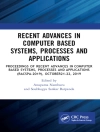This book provides readers with a comprehensive, state-of-the-art reference for miniaturized More-than-Moore systems with a broad range of functionalities that can be added to 3D microsystems, including flexible electronics, metasurfaces and power sources. The book also includes examples of applications for brain-computer interfaces and event-driven imaging systems.
- Provides a comprehensive, state-of-the-art reference for miniaturized More-than-Moore systems;
- Covers functionalities to add to 3D microsystems, including flexible electronics, metasurfaces and power sources;
- Includes current applications, such as brain-computer interfaces, event — driven imaging and edge computing.
Содержание
Introduction.- TSV and interposers.- Interconnects, including optical.- Simulations and reliability.- Sensors and cameras.- Integrated power sources.- Energy harvesters and power management.- Flexible and wearable electronics.- Photonics and/ or Antennas with metamaterials.- Neuromorphic computing for Io T.- Brain-computer interfaces.
Об авторе
Francesca Iacopi, MSc Physics (Rome, 1996), Ph D EE (KULeuven, 2004) has over 20 years’ international industrial and academic expertise in the miniaturisation of semiconductor technologies. She has led large R&D projects for IMEC (Belgium) and Globalfoundries Inc (USA) across electronic devices, interconnects, and packaging. She is known for her influential work in porous dielectrics for interconnects, and, more recently, graphene for on-chip applications. Recipient of an MRS Gold Graduate Student Award (2003), an ARC Future Fellowship (2012), and a Global Innovation Award in Washington DC (2014), she was listed among the most innovative engineers by Engineers Australia (2018). Francesca is a Fellow of the Institution of Engineers Australia and serves in several international technical committees for MRS and IEEE, including the Emerging Research Materials Chapter of the International Roadmap for Systems and Devices (irds.ieee.org). She leads the Integrated Nanosystems Lab at the University of Technology Sydney. She is a Core Member of the Centre for Clean Energy Technology at UTS, an Associate Investigator of the ARC Centre of Excellence in Low-Energy Electronics Technologies (FLEET) and a Chief Investigator of the Centre of Excellence in Transformative Meta-Optical Systems (TMOS). She is also founder and inaugural Chair of the IEEE NSW EDS Chapter.
Francis Balestra, CNRS Research Director at IMEP-LAHC, is Director of the European Sinano Institute and has been Director of several Laboratories, IMEP and LPCS, for a total of 10 years and. Within FP6, FP7 and H2020, he coordinated several European Projects (SINANO, NANOSIL, NANOFUNCTION, NEREID) that have represented unprecedented collaborations in Europe in the field of Nanoelectronics. He is member of the AENEAS Scientific Council, of the European Academy of Sciences, of the Advisory Committee of several International Journals, of the IRDS International Roadmap Committee, and of European Working Groups for Roadmapping activities. He is Editor-in-Chief of the ISTE Open Science Journal “Nanoelectronic Devices”, he founded or organized many international Conferences, and has co-authored a large number of books and publications. He is currently Vice-President of Grenoble INP, in charge of European activities.












